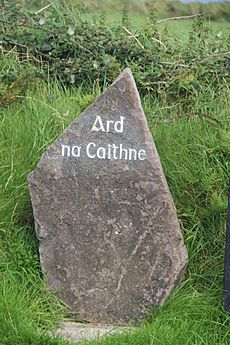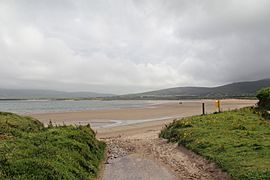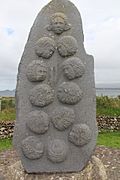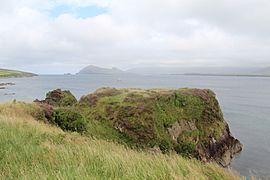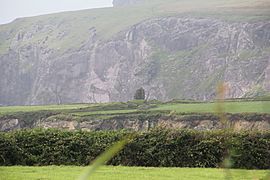Ard na Caithne facts for kids
Quick facts for kids
Ard na Caithne
Smerwick
|
|
|---|---|
|
Townland
|
|
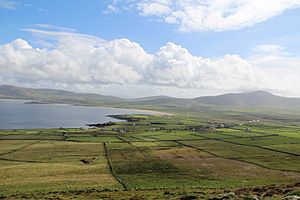
View over Ard na Caithne
|
|
| Country | Ireland |
| Province | Munster |
| County | County Kerry |
| Time zone | UTC+0 (WET) |
| • Summer (DST) | UTC-1 (IST (WEST)) |
| Irish Grid Reference | Q347072 |
Ard na Caithne, also known as Smerwick, is a beautiful bay and small area in County Kerry, Ireland. Its name means "height of the arbutus" or "strawberry tree".
This special place is found in Corca Dhuibhne, a peninsula in County Kerry. It sits at the base of An Triúr Deirfiúr (The Three Sisters mountains) and Mount Brandon. Nearby villages include Baile an Fheirtéaraigh, Baile na nGall, and Ard na Caithne itself.
This area is part of the Fíor-Ghaeltacht, which means it's a place where the Irish language is the main language spoken every day. It's a great spot to experience Irish culture and history!
Contents
What's in a Name?
The official Irish name, Ard na Caithne, means "height of the arbutus" or "height of the strawberry tree". These are types of plants found in the area.
In the past, people also called it Iorras Tuaiscirt, meaning "north peninsula". Another old Irish name was Gall-Iorras, which means "peninsula of the strangers".
The English name, Smerwick, comes from old Norse (Viking) words. Smoer meant "butter" and wick meant "harbour". So, Smerwick likely meant "butter harbour".
A Look at History
Ard na Caithne has a long and interesting history, with important events and ancient sites.
Early Christian Times
Near Ard na Caithne, you can find some very old Christian sites.
- The Gallarus Oratory is a unique stone church built without mortar.
- The Mainistir Riaisc is an ancient monastic site.
These places are important for understanding early Irish history and are popular with visitors.
The Desmond Rebellions
Ard na Caithne played a role in a big historical event called the Second Desmond Rebellion.
- In 1580, a group of about 600 soldiers from Italy and Spain arrived here.
- They came to help Irish and English Catholics who were rebelling against Elizabeth I of England.
- These soldiers built a fort called Dún an Óir, which means 'Fort of the Gold'. This fort was on a rocky point near the harbour.
The Siege of Smerwick
English and Irish forces soon surrounded Dún an Óir. This led to the Siege of Smerwick.
- After three days, the soldiers in the fort gave up.
- Sadly, most of the soldiers were killed after they surrendered.
- A famous English explorer, Walter Raleigh, was involved. He said he was just following orders from his commander.
The Harbour's Role
The harbour at Ard na Caithne was an important landing spot.
- It's where the soldiers for the Desmond Rebellion landed in 1580.
- Years before, in 1578, the explorer Martin Frobisher also landed here after his trip across the Atlantic Ocean.
Gallery
-
Smerwick massacre memorial
-
Remains of Caisleán an Fheirtéaraigh, castle of the poet Piaras Feiritéar



